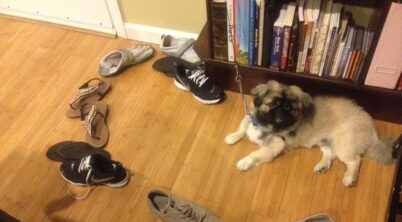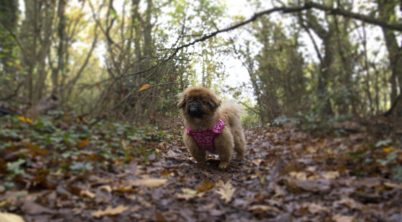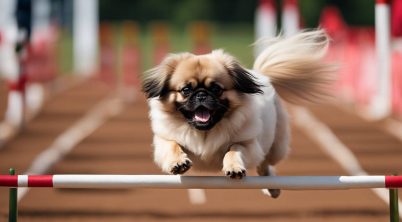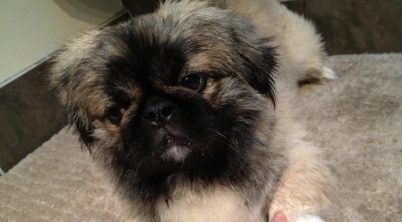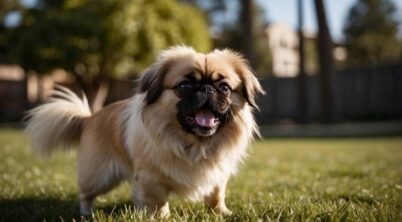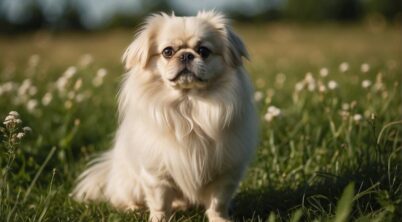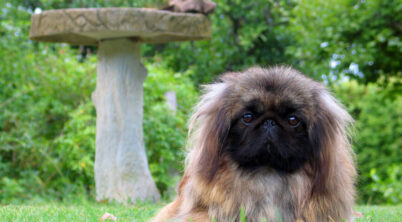The Pekingese breed is known for its distinctive lion-like appearance and affectionate temperament. As with any canine, the arrival of their heat cycle marks a significant stage in a Pekingese’s life, indicating that the dog has reached sexual maturity. Female Pekingese generally experience their initial heat, or estrous cycle, between six months and one year of age, although there may be variations depending on the individual dog’s development and size.
Understanding the heat cycle is crucial for responsible Pekingese ownership. This period encompasses several stages, with physical and behavioral changes that signal readiness for mating. During the early phase of the cycle, known as proestrus, owners may notice signs such as a swollen vulva and a blood-tinged discharge, which may last for a duration of seven to ten days.
It is important for owners to be aware of these changes not only to manage breeding intentions but also to provide proper care. A Pekingese in heat may require additional attention, comfort, and cleanliness to navigate this natural process effectively. Ensuring a calm environment and consulting with a veterinarian for advice can help maintain the well-being of a Pekingese during her heat cycle.
Table of Contents
Understanding the Heat Cycle in Pekingese
The Pekingese’s heat cycle is a crucial aspect of their reproductive health, which includes a series of stages manifested through both physiological and behavioral changes.
Stages of the Estrous Cycle
Proestrus: This stage is the beginning of the heat cycle, spanning around 7 to 10 days. During proestrus, you may observe the following:
- Vulva: Becomes swollen
- Vaginal Discharge: A bloody discharge is noticeable, signaling the start of the cycle
Estrus: The actual ‘heat’ stage, lasting about 5 to 9 days, is the period when the Pekingese is fertile and can conceive. Key pointers include:
- Vulva: Remains swollen
- Vaginal Discharge: Turns lighter in color, may become straw-colored or less bloody
- Behavioral Changes: Increased receptiveness to male dogs
Diestrus: This phase follows estrus and indicates the end of the female’s receptivity to males.
Anestrus: The final stage is a dormant phase with no sexual or hormonal activity, giving the reproductive system time to rest.
Signs and Symptoms of a Pekingese in Heat
During the heat cycle, a Pekingese dog exhibits several signs that owners should be aware of:
- Vulva: The vulva becomes swollen.
- Vaginal Discharge: There’s a presence of a blood-tinged discharge.
- Behavioral Changes: You may notice changes in behavior such as restlessness, increased urination, or a surge in affectionate behaviors due to pheromones.
Understanding these stages and symptoms can help owners provide better care during their Pekingese’s heat cycle.
Preparing for the First Heat Cycle
As owners anticipate the onset of their Pekingese’s first heat cycle, understanding the timing and changes that will occur is crucial for providing proper care.
Age of Onset
The first heat cycle in Pekingese typically begins between 6 and 12 months of age. This is an important period to monitor closely as it marks a significant developmental stage in a female’s life.
Physical and Behavioral Changes
During the heat cycle, owners will note both physical and behavioral changes.
Physical Changes:
- Swollen vulva
- Possible bloody discharge
Behavioral Changes:
- Increased restlessness or affectionate behavior
- Urination patterns may change, marking more frequently
Owners should ensure the Pekingese’s comfort by providing a calm environment and a safe place for her to rest. Hygiene is key; maintaining cleanliness during the cycle to prevent infections and discomfort is important. One should also be vigilant and refrain from leaving the Pekingese unsupervised outdoors to avoid unwanted male attention.
Health and Management During Heat
Managing the heat cycle of a Pekingese requires careful attention to hygiene, ensuring comfort, and controlling interactions with male dogs. These practices are crucial for preventing infections, minimizing stress, and maintaining the well-being of a female dog during this sensitive period.
Hygiene Practices
Hygiene is pivotal in preventing infections during the heat cycle. Owners should:
- Regularly check for any signs of excessive discharge or foul odors.
- Use dog diapers to manage bleeding, changing them frequently to maintain cleanliness.
- Clean the dog’s bedding and living quarters daily to eliminate bacteria and odors.
Exercise and Comfort
Exercise should be gentle during the heat cycle, with a focus on comfort:
- Shorten walks to avoid overexertion and reduce encounters with male dogs.
- Provide a calm and secure resting area away from loud noises and high traffic to alleviate stress.
- Extra attention can help a dog feel more at ease during heat.
Dealing with Male Dogs
To manage the presence of male dogs when a female is in heat:
- Supervise outdoor activities tightly to prevent unwanted mating.
- Avoid dog parks or areas where off-leash male dogs might be present.
- Consider scheduling playdates with familiar and neutered male dogs to safely expend energy.
Breeding and Pregnancy Considerations
The breeding and Pekingese pregnancy period requires attentive care and thorough planning. It is important for owners to understand the fertility cycle and the importance of timely medical care for a healthy pregnancy in dogs.
Mating and Fertility
The onset of a Pekingese’s first heat cycle typically occurs between six months and one year of age, marking the commencement of fertility. Responsible breeding practices necessitate waiting until at least the second or third heat cycle to ensure the dog is physically and emotionally mature enough for mating and carrying a pregnancy. Breeding a Pekingese during her first heat is strongly discouraged to avoid potential health risks.
- Optimal Timing for Mating: It is usually advised to mate a Pekingese during the estrus phase of her heat cycle when she is most fertile.
- Signs of Readiness: Owners should recognize changing behaviors indicating fertility, such as a Pekingese’s willingness to stand for a male or flagging (lifting of the tail).
Pregnancy Care and Planning
Upon successful mating, a Pekingese’s pregnancy lasts approximately 63 days. Proper care during this period is essential for the health of the mother and the litter. Pregnancy care should include a balanced diet, regular vet checkups, and an appropriate exercise routine to support optimal health.
- Diet and Health: A high-quality diet tailored for expectant mothers is crucial. Regular veterinary visits to monitor the health of the Pekingese and her puppies are important.
- Planning: Spaying a Pekingese can prevent unwanted pregnancies. For planned pregnancies, owners should arrange a suitable and quiet whelping area as the due date approaches.
Owners must ensure they are capable of providing for all the needs of a pregnant Pekingese and her offspring, including potential complications that may arise from breeding at too young of an age.
Health Concerns and Veterinary Care
During the first heat cycle, Pekingese dogs may face various health concerns that require careful management and veterinary care. It is crucial for owners to monitor their Pekingese during this time and be aware of common health issues related to the reproductive cycle.
Common Health Issues
- Pyometra: This is a serious uterine infection that can occur in dogs after estrus. Symptoms may include lethargy, loss of appetite, and excessive drinking or urination. Immediate veterinary treatment is crucial.
- Irregular Cycles: Keep track of the cycle duration; although it can vary, unusually long or short cycles may signal health issues.
- Vaginal Bleeding: Some bleeding is normal, but excessive blood loss requires veterinary attention.
Preventative Measures and Treatments
- Regular Check-Ups: Routine veterinary visits are important for monitoring a Pekingese’s health throughout her reproductive cycle. Blood tests can assess her overall health status.
- Spaying: Consider spaying to prevent unwanted pregnancies and reduce the risk of health complications such as pyometra and mammary tumors.
- Immediate Treatment: If any health concerns arise, timely veterinary treatment can prevent complications.
Effective monitoring and care during the first heat cycle can help ensure the health and well-being of a Pekingese dog.
Pekingese Specific Care and Nutrition
When addressing the care and nutrition of a Pekingese dog, it’s crucial to understand that their unique characteristics require attention. This breed is known for its abundant fur, which necessitates regular grooming. Brushing should occur several times a week to prevent shedding and mats in their coat. Owners are recommended to use a bristle brush for the long outer coat and a finer-toothed comb for the soft undercoat.
Bathing is an occasional necessity for the Pekingese, ideally only when the dog gets particularly dirty or starts to emit an odor. Over-bathing can strip their coat of natural oils, leading to skin irritation.
| Nutrient | Examples | Comments |
|---|---|---|
| Protein | High-quality dog food, meat | Essential for growth and maintaining muscle mass |
| Fruits | Blueberries, apples (no seeds) | Provides vitamins, but should be given in moderation |
| Fats | Flaxseed, fish oils | Supports a healthy coat and skin |
When it comes to nutrition, a balanced diet tailored to their needs is vital. Pekingese dogs often do well on high-quality commercial dog food that is formulated for small breeds. Incorporating lean meat is beneficial, as it provides the protein necessary for a healthy life.
Giving a Pekingese opportunities for light exercise will help maintain weight, as this breed can be prone to obesity. Always provide fresh water, and keep treats to a minimum. The American Kennel Club suggests monitoring their diet closely to avoid weight gain, which can place stress on their bodies.
In summary, caring for a Pekingese during their heat cycle, or at any time, requires conscientious grooming and a well-balanced diet to maintain their health and well-being.

